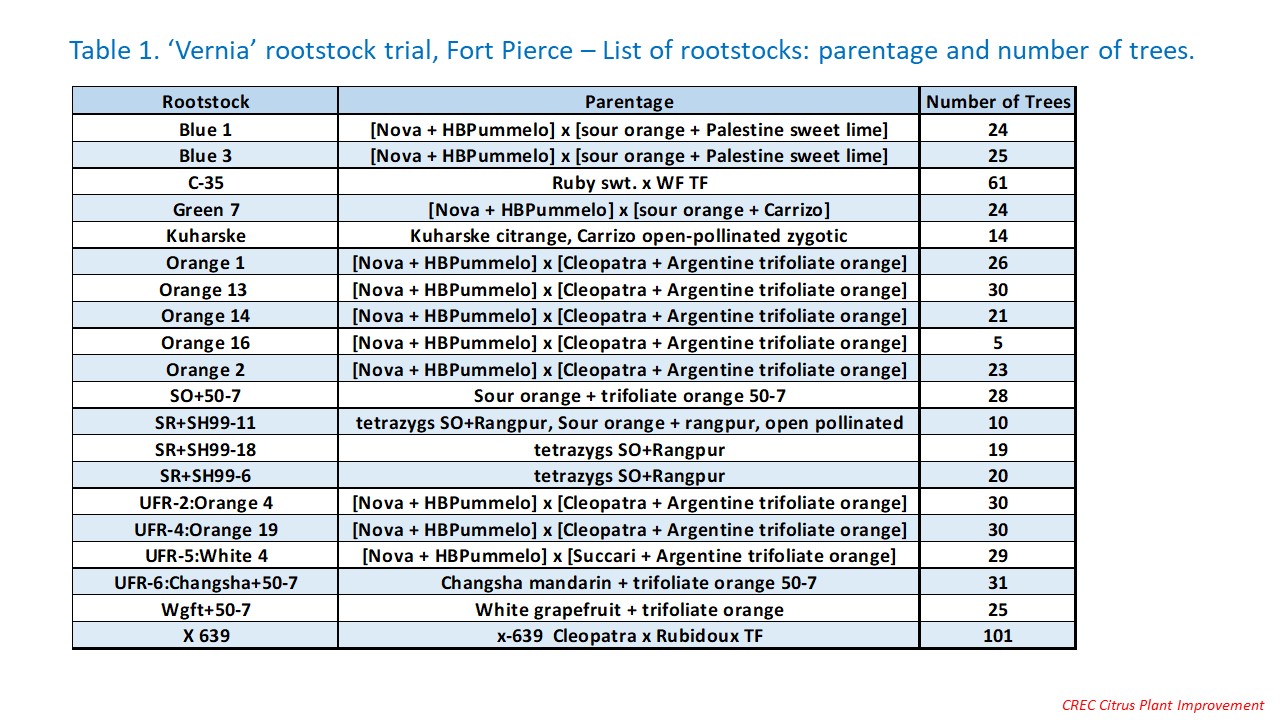‘Vernia’ Rootstock Trial, Fort Pierce
Dr. Bill Castle – Dr. Jude Grosser – Dr. Fred Gmitter
May 28, 2021 - Updated
November 16, 2020 - Updated
December 7, 2018 - Posted
CREC Citrus Plant Improvement
‘Vernia’ Rootstock Trial, Fort Pierce - Summary
This replicated trial planted in 2011 west of Ft. Pierce consists of ‘Vernia’ scion on 17 tetraploid rootstocks from the UF/CREC plant breeding program and 3 diploid commercial rootstocks (x639, C-35 and Kuharske) on Indian River flatwoods soil. The main purposes of this trial are to evaluate new rootstocks that, while under investigation elsewhere in Florida, have limited evaluation in flatwoods sites; and, determine HLB response. The tetraploid rootstocks selected for the trial are either somatic hybrids or “tetrazyg” hybrids produced by the conventional breeding of tetraploid somatic hybrids that have shown promise at other locations.
‘Vernia’ Rootstock Trial, Fort Pierce - Description
- Location: St. Lucie County
- Scion: Vernia – 20 rootstocks:
- Date planted: 2011
- Design: Randomized complete-block with 2 or 3 replications
- Plot size: 2-8 trees
- Spacing: 10 x 25 ft. [175 trees/acre]
- Data:
- 2015/16: Yield.
- 2017/18: Yield; HLB rating; tree size rating.
- 2018/19: Yield; HLB rating; juice quality, PS/acre.
- 2019/20: Yield; HLB rating.
- 2020/21: HLB rating and juice quality
- 4-year cumulative yield
- Trial status: ACTIVE
‘Vernia’ rootstock trial, Fort Pierce – Interpretive Summary as of May 2021:
This replicated trial was initiated in 2011 with 17 tetraploid hybrid rootstocks and 3 commercial rootstocks in a flatwoods site.
Tree survival. 100% after 10 years except for one rootstock [Table 2].
Tree height. At tree age 6 years, tree height ranged from 4ft to >8 ft [Fig. 4]. The smaller trees were those on Green 7, Orange 13, Blue 3 and others. Among the taller trees were ones on Orange 1, UFR 5, x639 and Kuharske. C-35 produced trees of intermediate size.
HLB. Visual symptoms were present among the trees, but the difference among rootstocks was not remarkable.
Yield. The cumulative yield of 4 years across the first 5 years of bearing was highest for trees on such rootstocks as x639, UFR-5, several Orange selections and Kuharske [Fig. 2]. Individual analysis of those 4 years indicated there were statistically significant differences among rootstocks when the yield difference between a pair of rootstocks exceeded about 0.5 to 0.7 boxes [Table 3].
Juice quality. The juice quality variables [Brix, acid, etc.] were not remarkably affected by rootstock.
PS/acre. In the 2018-19 season when the trees were 7 years old, the combination of yield with juice quality showed the trees on x639 to have the highest PS/acre [Fig. 11].
Rootstocks. In consideration of all the variables measured and rated, those rootstocks consistently among the top performers were x639 and Kuharske which grew well at the trial site, making relatively large, fruitful trees. Likewise, several of the new hybrids like UFR-5 and a few Orange selections would merit further field study.
Note that the outcomes experienced so far in this trial also point to particular rootstocks that could be considered advantageous in flatwoods sites. With emphasis placed on tree size and tree planting density, there are rootstocks like C-35 and others that had comparatively good overall credentials, but did not appear among the best performers because of smaller tree size. Nevertheless, those rootstocks would be quite acceptable at a more appropriate, "sweet spot," spacing.


.jpg)